Architecture and interior design fields have increasingly integrated audiovisual technologies into building experiences. From sophisticated home theaters to immersive museum installations, strategic AV integration enhances functionality and ambiance. Let's explore how various applications are influencing contemporary design approaches.
Digital Signage in Public Spaces
Large format video walls and distributed digital networks in transit hubs, malls and office lobbies relay wayfinding, promotional content seamlessly. Designers consider screen placements, sizes and resolution optimizing legibility from angles.
Standardized mounting specifications accommodate flexible installations. Power/data conduits future-proof upgrades. Ambient lighting integrates displays as architectural features. Dynamic content scheduling complements spatial uses throughout day. Modular systems simplify reconfiguration.
Immersive Experience Design
Experience centers, planetariums and mansions leverage projection mapping and spatialized audio transforming ordinary volumes into vivid illusionary landscapes. 3D modeling visualizes optimal surfaces, throw distances.
Acoustic treatments counteract reverberations maintaining ambiance. Distributed infrastructures coordinate synchronized multi-display scenarios across buildings. Motion tracking facilitates interactive content. Thoughtful layouts optimize flow promoting prolonged engagement.
Integrated Home Theaters
Hideaway home theaters integrate discreetly within residential design aesthetics. Acoustical materials temper reflections preserving pristine audio. Concealed equipment racks organize wire runs tidily.
Careful speaker/screen placement situates audiences optimally. Low-voltage lighting controls facilitate atmosphere adjustments seamlessly. Home automation harnesses theater systems for multi-purpose functionality flexibly according to lifestyle needs.
Control Room Design
Equipment racks, consoles organized thoughtfully optimize operators' ability to monitor complex systems ergonomically. HVAC, power ensure thermal manageability within equipment enclosures. Noise attenuating materials provide quiet focus.
Accessible pathways allow swift device servicing. Cable access points ease reconfigurations. Emergency power panels safeguard mission critical facilities. Visual wayfinding aids component locations disaster response personnel rapidly.
Sensory Modification
Sensory focused design attenuates overwhelm utilizing light/sound therapies. Interactive installations modulate stimuli supporting peace through mindfulness. Acoustic diffusers preserve speech clarity soothingly.
Modular, reconfigurable layouts accommodate varied abilities seamlessly. Wireless infrastructures eliminate hazards enabling free movement. Integrated biomonitoring provides therapeutic feedback encouraging self-regulation. Creative solutions nurture wellbeing.
Live Event Production
Large-scale venues demand technical zones housing audio/lighting/rigging systems thoughtfully organized alongside backstage areas, performer amenities. Load-bearing trusses facilitate robust rigging.
Hardened equipment enclosures protect against dust/moisture enabling outdoor productions. Sightline management minimizes visual obstructions. Accessible loading bays streamline load-ins. Immersive ambience stems from acoustical symmetry, spatial aesthetics.
Modular Design
Rapidly deployable stage/seating systems reconfigure space multi-functionally according to programming needing. Standard electrical/data interfaces expedite changeovers.
Knock-down enclosure solutions like tension fabric simplify storage. Portable production packages facilitate off-site events. Common dimensional standards promote interchangeability cutting waste. Resource sharing optimizes infrastructure utilization.
Smart Buildings
Integrating AV with building automation creates a cohesive user experience. Interactive wayfinding directs seamlessly across all digital surfaces. Environmental sensors customize lights/systems responsive to occupancy.
Interoperability marries otherwise independent sensors/systems within centralized control interfaces. Strategic cable pathways future-proof retrofitting emerging technologies sustaining real estate investment long term. Cybersecurity underpins all “smart” operations.
In closing, thoughtful audiovisual integration harmonizes functionality and ambiance enhancing how people interact within spaces. Architects and designers collaborating closely optimize emerging tech applications complementing spatial experiences through creativity and ingenuity.
Read More:- https://www.bloglovin.com/@avtechnology/innovations-in-audio-visual-services-for








